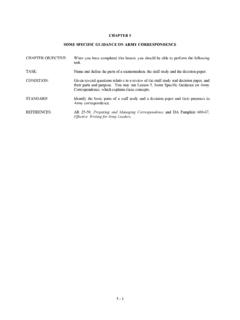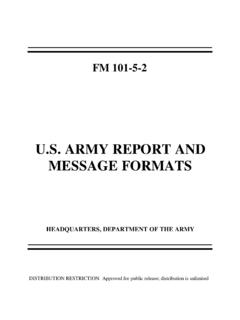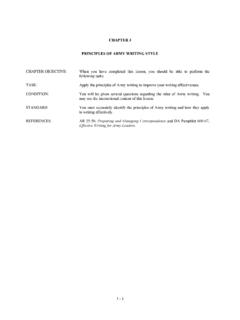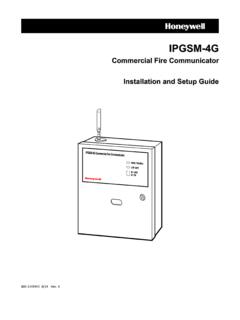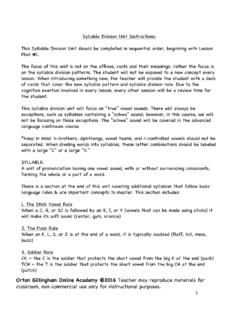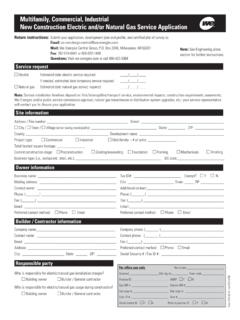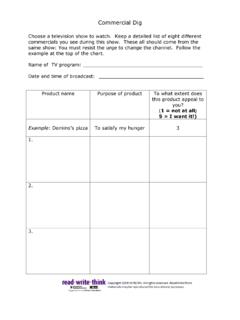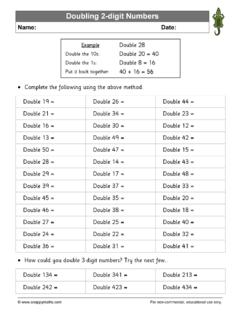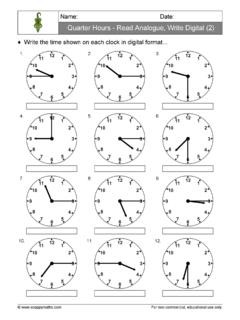Transcription of Personal Affairs Army Family Team Building (AFTB) Program
1 army Regulation 608 48. Personal Affairs army Family team Building (AFTB). Program Headquarters Department of the army Washington, DC. 20 October 2003. UNCLASSIFIED. SUMMARY of CHANGE. AR 608 48. army Family team Building (AFTB) Program This new regulation-- o Provides guidance for establishing and managing an army Family team Building Program . o Delineates Program responsibility and details the training aspects of the Program (chaps 2 and 3). o Provides funding and personnel management guidance (chap 4). Headquarters army Regulation 608 48. Department of the army Washington, DC. 20 October 2003 Effective 20 November 2003. Personal Affairs army Family team Building (AFTB) Program army civilian personnel, and the Family the regulation are invited to send com- members of each group. ments and suggested improvements on Proponent and exception authority. DA Form 2028 (Recommended Changes The proponent of this regulation is the to Publications and Blank Forms) directly Assistant Chief of Staff for Installation to Commander, army Community Management (ACSIM).
2 The ACSIM has and Family Support Center, ATTN: the authority to approve exceptions to this CFSC FP T (AFTB), Summit Centre, regulation that are consistent with control- 4700 King Street, Alexandria, Virginia ling law and regulation. The ACSIM may 22302 4418. delegate this authority, in writing, to a division chief within the proponent Committee Continuance Approval. agency in the grade of colonel or the ci- The Department of the army Committee vilian equivalent. Management Officer concurs in the estab- lishment of the army Family team Build- army management control process. This regulation contains management con- ing Advisory Council as an Intra- army trol provisions and identifies key manage- Committee, 1 July 2002. History. This publication is a new Department of the army regulation. ment controls that must be evaluated. See Distribution. This publication is availa- appendix B. ble in electronic media only and is in- Summary. This regulation provides guidance for the establishment and admin- Supplementation.
3 Supplementation of tended for command levels C, D, and E. istration of an army Family team Build- this regulation and establishment of com- for the Active army , the army National ing Program . mand and local forms are prohibited with- Guard of the United States, and the out prior approval from the Assistant army Reserve. Applicability. This regulation applies to Chief of Staff for Installation Manage- the Active army , the army National ment (ATTN: DAIM ZA), 600 army Guard of the United States, the Pentagon, Washington, DC 20310 0600. army Reserve, retirees, Department of the Suggested improvements. Users of Contents (Listed by paragraph and page number). Chapter 1. Overview, page 1. Purpose 1 1, page 1. References 1 2, page 1. Explanation of abbreviations and terms 1 3, page 1. Authority 1 4, page 1. Mission 1 5, page 6. Background 1 6, page 6. Eligibility 1 7, page 6. army Family team Building Day 1 8, page 6. Chapter 2. Oversight, page 7. Section I. Responsibilities, page 7.
4 AR 608 48 20 October 2003 i UNCLASSIFIED. Contents Continued The Assistant Chief of Staff for Installation Management 2 1, page 7. The Chief, National Guard Bureau 2 2, page 7. The Chief, army Reserve 2 3, page 8. The Judge Advocate General 2 4, page 8. Commander, army Community and Family Support Center 2 5, page 8. Commanders, major army commands 2 6, page 8. Installation, Garrison, State Area Regional Command, Regional Readiness Command, and army Reserve Command Commanders 2 7, page 9. Commanders at all levels 2 8, page 9. Local/unit/community paid AFTB Program Managers or volunteer AFTB Program Managers 2 9, page 9. Section II. Volunteer Roles and Duties, page 10. AFTB advisory council 2 10, page 10. Key volunteer personnel 2 11, page 10. Section III. Assessment and compliance, page 11. General 2 12, page 11. Annual review and strategic planning 2 13, page 11. Section IV. Recordkeeping Requirements, page 11. General 2 14, page 11. Complying with Federal Law 2 15, page 12.
5 Important information to be saved 2 16, page 12. Chapter 3. Elements of the AFTB Program , page 12. Program description 3 1, page 12. Principles of the training 3 2, page 12. Goal of the Program 3 3, page 12. Elements of the AFTB training Program are levels I, II, III, Master Trainer, Core Instructor Training, Senior Spouse Leadership Seminars, and Master Trainer Professional Development and Program Manager course 3 4, page 12. The AFTB NetTrainer System 3 5, page 15. Chapter 4. Management, page 15. Section I. Funding, page 15. Appropriated funds 4 1, page 15. Nonappropriated funds 4 2, page 16. Volunteer incidental expense reimbursement 4 3, page 16. Commercial sponsorship 4 4, page 16. Gifts and donations 4 5, page 16. Section II. Program Personnel, page 16. army Family team Building staff 4 6, page 16. Program alignment 4 7, page 16. Paid staff 4 8, page 16. Volunteer staff 4 9, page 17. Section III. Training, page 17. ii AR 608 48 20 October 2003. Contents Continued army Family team Building training 4 10, page 17.
6 Additional training 4 11, page 17. Section IV. Physical Property, page 17. Property control 4 12, page 17. Logistical requirements 4 13, page 17. Section V. Marketing, page 18. User awareness 4 14, page 18. Marketing Plan 4 15, page 18. Chapter 5. Volunteer Leadership and Management, page 18. Guidelines 5 1, page 18. Recordkeeping 5 2, page 18. Transfer of volunteer records and services 5 3, page 18. Appendixes A. References, page 19. B. Management Control Evaluation Process, page 20. Table List Table 2 1: Volunteer Roles and Duties, page 11. Table 3 1: DA Minimum Standards for Instructor Training, page 13. Figure List Figure 1 1: army Family team Building Memorandum, page 2. Figure 1 2: Reshaping Family Programs for the 21st Century Memorandum, page 4. Figure 1 2: Reshaping Family Programs for the 21st Century Memorandum Continued, page 5. Figure 1 3: AFTB Proclamation and Logo, page 7. Glossary AR 608 48 20 October 2003 iii Chapter 1. Overview 1 1. Purpose a.
7 The army Family team Building (AFTB) is a global educational Program whose primary objective is to improve the overall readiness of the force by teaching and promoting Personal and Family readiness through standardized, progressive, and sequential education of Family members; however, the Program can be used flexibly to meet the needs of the individual audience. Its purpose is to assist members of the army in adapting to army life, manage change, and accept challenges. It is to be implemented at army installations and army communities worldwide. It is not intended to displace existing programs for Family members that provide mutual support, assistance, and communication but to enhance such programs and materials as army Community Service (ACS), the army Family Action Plan (AFAP), mayoral programs, Better Opportunities for Single Soldiers (BOSS), Operation , and Family Readiness Groups (FRGs) in units. b. The AFTB plays an integral part in the Family programs of the army .
8 Such programs emphasize military and Personal preparedness. They outline commanders' responsibilities to ensure assistance in establishing and maintaining the highest possible level of readiness (AR 600 20). c. This regulation addresses the AFTB Program . The intent is to outline policy, responsibilities, and Program description. 1 2. References Required and related publications and prescribed and referenced forms are listed in appendix A. 1 3. Explanation of abbreviations and terms Abbreviations and terms used in this regulation are explained in the glossary. 1 4. Authority a. The AFTB Program policy memorandum issued on 16 December 1994, signed by the Chief of Staff of the army (CSA) and the Sergeant Major of the army (SMA), announced AFTB as an official army Program . The memorandum is at figure 1 1. AR 608 48 20 October 2003 1. Figure 1 1. army Family team Building Memorandum 2 AR 608 48 20 October 2003. b. In a memorandum dated 17 April 1996, the CSA endorsed AFTB as the primary army Program promoting self- reliance through education.
9 This memorandum is at figure 1 2. AR 608 48 20 October 2003 3. Figure 1 2. Reshaping Family Programs for the 21st Century Memorandum 4 AR 608 48 20 October 2003. Figure 1 2. Reshaping Family Programs for the 21st Century Memorandum Continued AR 608 48 20 October 2003 5. c. To date, there are no legislative directives for the AFTB Program . 1 5. Mission The AFTB mission is to educate and empower members of the military community to develop skills and encourage behaviors that strengthen self-reliance, promote retention, and enhance readiness. 1 6. Background a. The AFTB is a direct result of lessons learned from Operation Desert Shield and Desert Storm. A brief chronological history is located on the AFTB Web site, b. The principles of partnership, wellness, and a sense of community (as identified by the CSA in the White paper, The army Family , on 15 August 1983) have been the hallmarks in the relationship of the army with its families. c. There was a need for education promoting self-reliance for all the army that reaches young army spouses, spouses new to the army , as well as those with experience in the army lifestyle.
10 D. The AFTB was developed and has evolved as the army 's primary Program to meet the educational needs of army spouses and Family members, and provide them with the skills and knowledge to enhance Family readiness. e. The basic philosophy of AFTB is the belief that individuals can function at a high level in any situation with minimal outside support when they have been appropriately trained. The training will be conducted by trained AFTB. volunteers. 1 7. Eligibility a. Family members of the Active army , the army National Guard (ARNG), the United States army Reserve (USAR), the Department of army civilians (DACs), and retirees are eligible to participate in the AFTB Program . Family members are the primary target audience. b. Soldiers of the Active army , ARNG, USAR and retirees are eligible to participate in the AFTB Program . c. Department of army Civilians (DACs) and other paid AFTB Program personnel (to include contractors) are eligible to participate in the AFTB Program .
